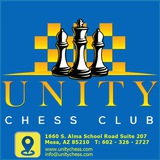Rd 6 at Sinquefield Cup: Caruana beat Karjakin. Grischuk-Carlsen, Mamedyarov-Vachier_Lagrave, Nakamura-Aronian, and So-Anand all drew. Caruana leads with 4 out of 6. Aronian, Mamedyarov, Grischuk, and Carlsen all have 3.5 out of 6. Anand and MVL have 3 out of 6. so has 2.5/6.
Today Fabiano Caruana faces off against #WorldChampion Magnus Carlsen.
#chessnews
Today Fabiano Caruana faces off against #WorldChampion Magnus Carlsen.
#chessnews
Caruana,-Fabiano_vs_Karjakin,-Sergey_2018-08-24.pgn
5 KB
🔹 Caruana, Fabiano (2822) vs. Karjakin, Sergey (2773) -Sinquefield Cup 2018
🔹 PGN format
🔹 Analysed by Chess.com
@UnityChess
🔹 PGN format
🔹 Analysed by Chess.com
@UnityChess
♦️Today is Birthday of Arpad Elo
♦️ The Elo Rating System Creator
. . . . . . . . . . . . .
@unitychess
♦️ The Elo Rating System Creator
. . . . . . . . . . . . .
@unitychess
✳️✳️✳️✳️
🔰 The Elo rating system
🔹 Elo is best known for his system of rating chess players. The original chess rating system was developed in 1950 by Kenneth Harkness, the Business Manager of the United States Chess Federation. By 1960, using the data developed through the Harkness Rating System, Elo developed his own formula which had a sound statistical basis and constituted an improvement on the Harkness System. The new rating system was approved and passed at a meeting of the United States Chess Federation in St. Louis in 1960.
🔹In 1970, FIDE, the World Chess Federation, agreed to adopt the Elo Rating System. From then on until the mid-1980s, Elo himself made the rating calculations. At the time, the computational task was relatively easy because fewer than 2000 players were rated by FIDE.
🔹FIDE reassigned the task of managing and computing the ratings to others, excluding Elo. FIDE also added new "Qualification for Rating" rules to its handbook awarding arbitrary ratings (typically in the 2200 range, which is the low end for a chess master) for players who scored at least 50 percent in the games played at selected events, such as named Chess Olympiads.[4][5] Elo and others[who?] objected to these new rules as arbitrary and politically driven.
. . . . . . . . . . . . .
@unitychess
🔰 The Elo rating system
🔹 Elo is best known for his system of rating chess players. The original chess rating system was developed in 1950 by Kenneth Harkness, the Business Manager of the United States Chess Federation. By 1960, using the data developed through the Harkness Rating System, Elo developed his own formula which had a sound statistical basis and constituted an improvement on the Harkness System. The new rating system was approved and passed at a meeting of the United States Chess Federation in St. Louis in 1960.
🔹In 1970, FIDE, the World Chess Federation, agreed to adopt the Elo Rating System. From then on until the mid-1980s, Elo himself made the rating calculations. At the time, the computational task was relatively easy because fewer than 2000 players were rated by FIDE.
🔹FIDE reassigned the task of managing and computing the ratings to others, excluding Elo. FIDE also added new "Qualification for Rating" rules to its handbook awarding arbitrary ratings (typically in the 2200 range, which is the low end for a chess master) for players who scored at least 50 percent in the games played at selected events, such as named Chess Olympiads.[4][5] Elo and others[who?] objected to these new rules as arbitrary and politically driven.
. . . . . . . . . . . . .
@unitychess
Bobby Fischer in the Marshall Club playing by telex in the Capablanca Memorial held in Havana in 1965.
Source: Chess Life, Sep 1965, page 191, taken from "Vindication for Bobby Fischer.
@UnityChess
Source: Chess Life, Sep 1965, page 191, taken from "Vindication for Bobby Fischer.
@UnityChess
Moscow, 5th December 1976. In the 6th round of the 44th USSR Championship, World Champion Anatoly Karpov faces Belorussian master Viktor Kupreichik.
@UnityChess
@UnityChess
This media is not supported in your browser
VIEW IN TELEGRAM
☑️ USSR Championship (1976), Moscow
⚪️ Anatoly Karpov
⚫️ Viktor Kupreichik
Spanish Game: Bird Variation (C61)
Result : 1-0
@UnityChess
⚪️ Anatoly Karpov
⚫️ Viktor Kupreichik
Spanish Game: Bird Variation (C61)
Result : 1-0
@UnityChess
Leonid Stein (USSR 'A') in play v. Eduard Gufeld (USSR 'B') in the National Tournament of 3 Teams in Moscow, April 24th, 1973.
@UnityChess
@UnityChess
This was Stein's last tournament - his sudden death at the age of 38 a few months later shocked the chess world.
@UnityChess
@UnityChess
♦️ Today is birthday of Vasilios Kotronias
Greek chess grandmaster and chess author
🌺 🌹🌷🌸💐☘️🌹 Happy birthday Vasilios 👏👏👏👏
. . . . . . . . . . . . .
@unitychess
Greek chess grandmaster and chess author
🌺 🌹🌷🌸💐☘️🌹 Happy birthday Vasilios 👏👏👏👏
. . . . . . . . . . . . .
@unitychess
🛄 #Kotronias_chess_Quotes_001
🔹 Vasilios Kotronias
🔹Greek chess grandmaster and chess author
. . . . . . . . . . . . .
@unitychess
🔹 Vasilios Kotronias
🔹Greek chess grandmaster and chess author
. . . . . . . . . . . . .
@unitychess
